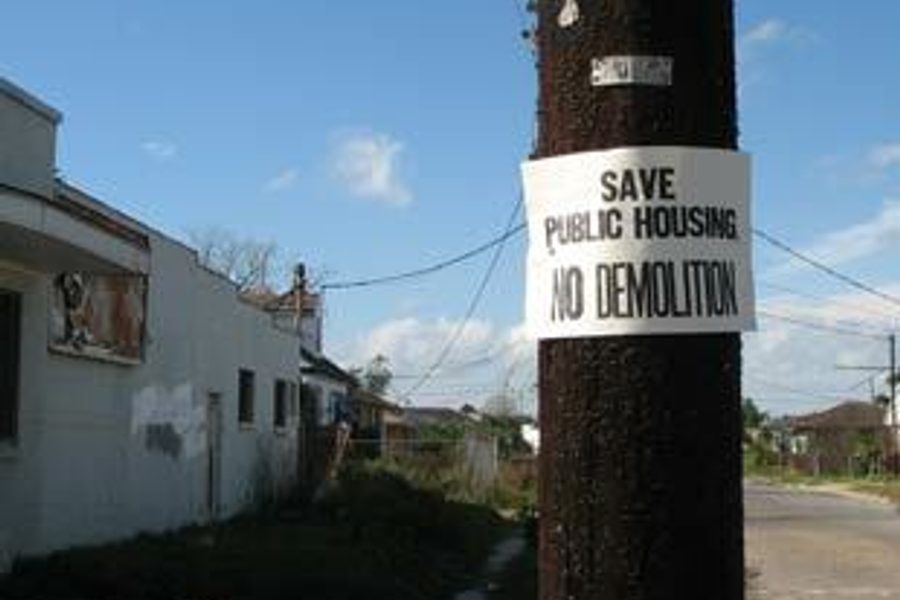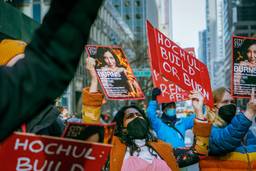
The temperature in New Orleans was uncharacteristically cold in mid-December, dipping into the 30s. As thousands of homeless people living in encampments huddled in blankets, housing activists from around the country converged on the city to protest the demolition of more than 4,500 units of public housing, once at the epicenter of New Orleans’ low-income African-American community.
In late November, the Housing Authority of New Orleans (HANO) had approved $30 million in contracts to demolish the B.W. Cooper, C.J. Peete, Lafitte and St. Bernard projects. Public housing residents, lawyers, religious leaders and activists who attempted to stop the demolitions met police head on. But their efforts succeeded in delaying some demolition and gaining significant national support.
On Dec. 20, however, police fought activists from the Coalition to Protect Public Housing with pepper spray and Tasers on the steps of New Orleans City Hall.
The Department of Housing and Urban Development (HUD) plans to demolish the majority of New Orleans’ historic public housing and replace it with so-called mixed-income neighborhoods. The post-Hurricane Katrina environment of government inattention and slashing of public services created an opening for HUD (which has controlled HANO since 2002) to execute a plan it claims was in the works prior to the storm.
Since Katrina, the homeless population of New Orleans has doubled to more than 12,000 people. Despite what the New York Times on Dec. 2 called an “acute rental shortage,” HUD plans to spend $762 million to demolish public housing and replace it with only 744 new units of affordable housing. HUD will spend an average of $400,000 for each new mixed-income unit, while statements by HANO’S own insurance company have shown that many of the multiple-unit buildings to be demolished could be repaired for less than $10,000 per building.
A human need
“Get these people off the street. It’s cold outside!” said Sharon Jaspers, 58, a housing activist and former lifelong resident of the St. Bernard Projects in the 7th Ward. Jaspers, who spoke on the steps of City Hall on Dec. 18, was referring to the dozens of homeless activists and members of Homeless Pride camped out across the street in Duncan Plaza since July 4, 2007 to protest the lack of affordable housing. By mid-December, local charities were helping the hundreds of homeless secure housing after the city announced its intention to fence off the square and kick out residents.
Jaspers herself was among the tens of thousands displaced from St. Bernard in September 2005. She now rents an apartment on Dumaine Street near downtown. Like many other New Orleanians, Jaspers says she is overwhelmed by high utility bills and terrible building maintenance.
In October 2006 a (New Orleans) Times-Picayune survey concluded that rents in Orleans Parish had gone up an average of 70 percent since the storm, and in some neighborhoods rents continue to rise.
“Our people work and they pay taxes,” says Jaspers. “Housing is a human need and it’s a human right. We have a right to be a part of this process.” Jaspers says HUD wants to rid the city of poor people rather than involve them in the rebuilding process. “They wanted to make this a city for the rich,” she says. “They’re not thinking about poor, working-class people. All they had to do is revitalize some units, let the displaced families come home, and then start talking about redevelopment.”
The St. Bernard housing projects have stood empty since the forced evacuation during Hurricane Katrina in 2005. Although the sturdy brick apartments suffered only minor water damage and could have been rehabilitated, HUD and the city of New Orleans fenced off the row houses and kicked out former residents who attempted to squat in their own homes. Residents began immediately protesting their displacement.
On June 14, 2006, HUD and HANO announced demolition plans. And on June 26, a group of African-American public housing residents filed a class-action lawsuit, citing the agencies’ obligation to “provide nondiscriminatory access to safe, affordable housing” and to keep contractual commitments to residents with leases.
The residents pointed to HUD Secretary Alphonso Jackson’s statement in September 2005 that New Orleans “is not going to be as black as it was for a long time, if ever again.” In April 2006, Jackson publicly stated that “[o]nly the best [public housing] residents should return. Those who paid rent on time, those who held a job and those who worked.” (The FBI is now investigating Jackson for alleged inside dealings with HUD contracts in New Orleans.)
The right of return
Public housing in New Orleans was nearly 100 percent black at the time of the storm in 2005.
“They want to rid this city of black folks,” said Malcolm Suber, a long-time local activist and one of the founders of the People’s Hurricane Relief Fund. “We have livable spaces across the street from here and people can’t live in them.”
Suber spoke at a Dec. 15 demonstration outside St. Bernard, where about 100 people celebrated with food, music, dancing and speeches following a Dec. 14 state court order that forced City Council to take an active stance on the demolitions before HUD could proceed with its plans.
Kali Akuno, 35, the national organizer for the Malcolm X Grassroots Movement and one of the coordinators of the Coalition to Stop the Demolitions, said he believes the privatization of the city is a result of national right-wing efforts to privatize social services.
“HUD is destroying the material basis for the right of return,” says Akuno, who sees St. Bernard as the epicenter of New Orleans’ housing struggle.
Akuno says St. Bernard could house some of the tens of thousands of people receiving eviction notices from FEMA trailers, or used as transitional housing for the growing homeless population.
Shortly after Akuno and others spoke at the Dec. 15 demonstration, police had a skirmish with protesters, arresting activist Cheri Honkala for allegedly “impersonating an officer.” Honkala says she stepped out into the street to try to prevent a passing car from striking protesters. When Chicago-based activist Willie J.R. Fleming challenged Honkala’s arrest, he says police cuffed him and threw him against a car. One cameraman, Richard Rowley of New York-based Big Noise Films, filmed Fleming’s arrest.
Fleming, who is a director at the Chicago Coalition to Protect Public Housing, traveled with eight resident organizers from Cabrini Green housing projects in Chicago, where residents have been fighting demolitions since the late ’90s.
Locked out
On Dec. 10, the Housing Conservation District Review Committee in New Orleans denied a permit to demolish Lafitte, an older development known for its sturdy townhouse-style construction. HUD immediately threatened to cut off funding and housing vouchers for former Lafitte residents if Lafitte is not demolished.
As protests continued on the ground, Sens. Barack Obama (D-Ill.) and Harry Reid (D-Nev.), as well as House Speaker Nancy Pelosi (D-Calif.), publicly requested a moratorium on the demolitions until more research is done into one-for-one replacement and the immediate needs of displaced residents. The Gulf Coast Recovery Act of 2007 would require a plan for replacement before demolitions begin. But as of December, the bill was held up in committee and lacked the key support of Louisiana’s Republican Sen. David Vitter.
Despite the opposition, on Dec. 20, New Orleans’ City Council voted unanimously to approve the demolitions without formally meeting with residents. Before the vote, city officials locked out nearly 100 people who showed up to give input, claiming the council chambers were full.
When people inside demanded that more folks be let in, police reportedly tasered at least five leaders and dragged them out. Protesters who approached the gates after witnessing this were also reportedly tasered and pepper-sprayed. Fifteen people were arrested and one woman was rushed to the hospital when she began having seizures due to tasers.
That morning, New Orleans Mayor Ray Nagin sent a letter to City Council saying he had reached verbal agreements with HUD Secretary Jackson over rehabilitating a minimum number of units at Lafitte and St. Bernard, assuring that redevelopment begins directly after the demolitions, and expanding HANO’s one-person board of directors to three people, including the mayor and a public housing resident, as a means for “local input and oversight.”
If Nagin’s words have weight, they could at least lead to a pause in the action while HUD, HANO and the City Council try to wait out the national attention.
“This image is not what they want to portray,” says Akuno, referring to the protests and the homeless encampments. “It’s not good for business.”
Jaspers spoke with In These Times on the phone the day after Christmas as she waited for her daughter to fly in from Houston. Her four children, all from New Orleans, are now scattered around the country. She says Christmas has changed for her and her family since the storm.
Despite the physical, emotional and spiritual trauma, Jaspers says she will return to New Orleans along with many other longtime residents and their allies.
“It can make you bitter,” says Jaspers, “and I’m tired of watching my people suffer. But I refuse to lay down.”







